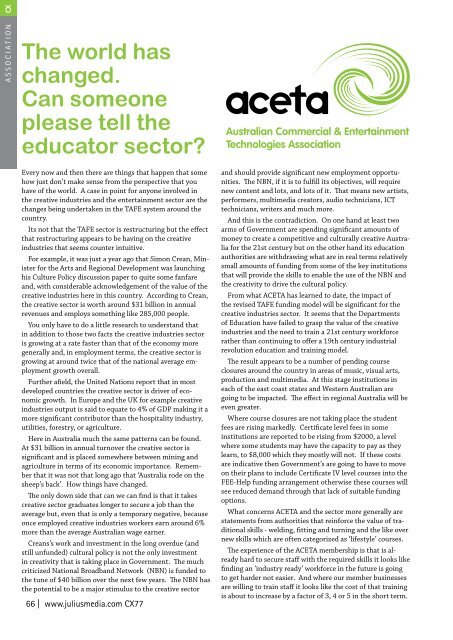Download File
Download File
Download File
You also want an ePaper? Increase the reach of your titles
YUMPU automatically turns print PDFs into web optimized ePapers that Google loves.
ASSOCIATION<br />
The world has<br />
changed.<br />
Can someone<br />
please tell the<br />
educator sector?<br />
Every now and then there are things that happen that some<br />
how just don’t make sense from the perspective that you<br />
have of the world. A case in point for anyone involved in<br />
the creative industries and the entertainment sector are the<br />
changes being undertaken in the TAFE system around the<br />
country.<br />
Its not that the TAFE sector is restructuring but the effect<br />
that restructuring appears to be having on the creative<br />
industries that seems counter intuitive.<br />
For example, it was just a year ago that Simon Crean, Minister<br />
for the Arts and Regional Development was launching<br />
his Culture Policy discussion paper to quite some fanfare<br />
and, with considerable acknowledgement of the value of the<br />
creative industries here in this country. According to Crean,<br />
the creative sector is worth around $31 billion in annual<br />
revenues and employs something like 285,000 people.<br />
you only have to do a little research to understand that<br />
in addition to those two facts the creative industries sector<br />
is growing at a rate faster than that of the economy more<br />
generally and, in employment terms, the creative sector is<br />
growing at around twice that of the national average employment<br />
growth overall.<br />
Further afield, the United Nations report that in most<br />
developed countries the creative sector is driver of economic<br />
growth. In Europe and the UK for example creative<br />
industries output is said to equate to 4% of GDP making it a<br />
more significant contributor than the hospitality industry,<br />
utilities, forestry, or agriculture.<br />
Here in Australia much the same patterns can be found.<br />
At $31 billion in annual turnover the creative sector is<br />
significant and is placed somewhere between mining and<br />
agriculture in terms of its economic importance. Remember<br />
that it was not that long ago that ‘Australia rode on the<br />
sheep’s back’. How things have changed.<br />
The only down side that can we can find is that it takes<br />
creative sector graduates longer to secure a job than the<br />
average but, even that is only a temporary negative, because<br />
once employed creative industries workers earn around 6%<br />
more than the average Australian wage earner.<br />
Creans’s work and investment in the long overdue (and<br />
still unfunded) cultural policy is not the only investment<br />
in creativity that is taking place in Government. The much<br />
criticized National Broadband Network (NBN) is funded to<br />
the tune of $40 billion over the next few years. The NBN has<br />
the potential to be a major stimulus to the creative sector<br />
66 | www.juliusmedia.com CX77<br />
and should provide significant new employment opportunities.<br />
The NBN, if it is to fulfill its objectives, will require<br />
new content and lots, and lots of it. That means new artists,<br />
performers, multimedia creators, audio technicians, ICT<br />
technicians, writers and much more.<br />
And this is the contradiction. On one hand at least two<br />
arms of Government are spending significant amounts of<br />
money to create a competitive and culturally creative Australia<br />
for the 21st century but on the other hand its education<br />
authorities are withdrawing what are in real terms relatively<br />
small amounts of funding from some of the key institutions<br />
that will provide the skills to enable the use of the NBN and<br />
the creativity to drive the cultural policy.<br />
From what ACETA has learned to date, the impact of<br />
the revised TAFE funding model will be significant for the<br />
creative industries sector. It seems that the Departments<br />
of Education have failed to grasp the value of the creative<br />
industries and the need to train a 21st century workforce<br />
rather than continuing to offer a 19th century industrial<br />
revolution education and training model.<br />
The result appears to be a number of pending course<br />
closures around the country in areas of music, visual arts,<br />
production and multimedia. At this stage institutions in<br />
each of the east coast states and Western Australian are<br />
going to be impacted. The effect in regional Australia will be<br />
even greater.<br />
Where course closures are not taking place the student<br />
fees are rising markedly. Certificate level fees in some<br />
institutions are reported to be rising from $2000, a level<br />
where some students may have the capacity to pay as they<br />
learn, to $8,000 which they mostly will not. If these costs<br />
are indicative then Government’s are going to have to move<br />
on their plans to include Certificate IV level courses into the<br />
FEE-Help funding arrangement otherwise these courses will<br />
see reduced demand through that lack of suitable funding<br />
options.<br />
What concerns ACETA and the sector more generally are<br />
statements from authorities that reinforce the value of traditional<br />
skills - welding, fitting and turning and the like over<br />
new skills which are often categorized as ‘lifestyle’ courses.<br />
The experience of the ACETA membership is that is already<br />
hard to secure staff with the required skills it looks like<br />
finding an ‘industry ready’ workforce in the future is going<br />
to get harder not easier. And where our member businesses<br />
are willing to train staff it looks like the cost of that training<br />
is about to increase by a factor of 3, 4 or 5 in the short term.


